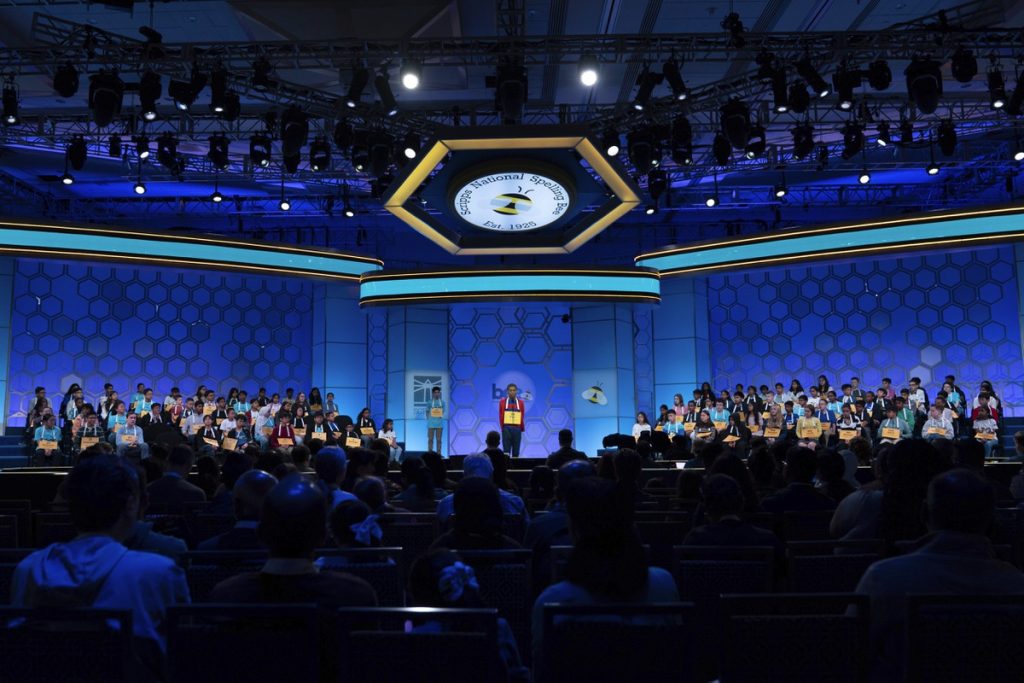Friday, May 30, 2025 | 2 a.m.
Editor’s note: “Behind the News” is the product of Sun staff assisted by the Sun’s AI lab, which includes a variety of tools such as Anthropic’s Claude, Perplexity AI, Google Gemini and ChatGPT.
The Scripps National Spelling Bee, staged this week in Maryland, is a prestigious annual competition with a rich history and a significant cultural impact.
Here is an explainer detailing its history, growth, television influence, rules, qualification process, word sources, difficult words and notable winners.
History and growth of the Scripps National Spelling Bee
The National Spelling Bee began in 1925 when nine newspapers collaborated to host a spelling competition for their champion spellers. It was originally a literacy initiative that has grown immensely over the past century[1].
The bee has evolved from a small event to a nationally recognized educational program that inspires lifelong curiosity about words and celebrates academic achievement[1].
It is staged annually near Washington at a large convention center, drawing participants from across the U.S. and several other countries[2].
The competition was canceled during World War II (1943-1945) and in 2020 due to the COVID-19 pandemic but otherwise has run continuously[2].
Indian American students have dominated the competition in recent decades, winning 29 of 35 titles since 1999[2].
How TV transformed the bee
Television has played a crucial role in elevating the popularity of the Scripps National Spelling Bee over the years by making the event more accessible, engaging and widely viewed:
Early TV coverage and growth: The bee first gained national TV exposure through CNN and later ESPN, which began broadcasting the national finals in 1994. ESPN enhanced the event’s appeal by adding competitor profiles and analysis, helping to bring greater prominence and a more compelling narrative to viewers[6].
Primetime exposure: In 2006, the bee finals moved to primetime on ABC, positioning it as a form of reality television and capitalizing on broader cultural interest, including the release of the film “Akeelah and the Bee.” This shift helped attract a larger and more diverse audience beyond traditional educational program viewers[7].
Viewership growth: This move to free, widely available TV networks led to a dramatic increase in viewership. For example, the 2022 finals drew a 147% increase in audience over 2021, reaching the largest TV audience since 2015, with 7.5 million viewers watching overall programming including semifinals and specials[1,4]. The 2023 semifinals and finals attracted 9.2 million viewers, a 22% increase over 2022, with the finals alone reaching 6.1 million viewers — the largest since 2012[2,3].
Competition format
The bee consists of four segments: Preliminaries, quarterfinals, semifinals and finals[5].
Preliminaries include three rounds: one spelling round, one multiple-choice vocabulary round and additional spelling rounds[5].
Spellers must spell words correctly or answer vocabulary questions correctly to advance; a single mistake typically results in elimination[5].
After preliminaries, a written spelling and vocabulary test is administered; the top approximately 100 spellers advance to the quarterfinals[2].
Oral spelling and vocabulary rounds continue through quarterfinals and semifinals, eliminating spellers until about a dozen reach the finals[2].
When only two spellers remain, a “spell-off” lightning round may be used to determine the champion, though its timing is flexible[2].
In the final rounds, spellers may spell dozens of words; for example, the 2024 champion Bruhat Soma spelled 29 words correctly in the final spell-off round[1].
Word sources
Words used in the competition are drawn from the Merriam-Webster Unabridged dictionary, which has been the official dictionary partner for over 50 years[1,2].
The bee collaborates closely with Merriam-Webster to select interesting and meaningful words that challenge the best spellers[1].
Qualification process
Spellers advance through a series of local and regional competitions hosted by bee sponsors across the U.S. and territories[2].
They must meet eligibility requirements regarding age and grade level[2,4].
The top spellers from regional bees qualify for the national competition[2].
Notable difficult words
The bee is known for extremely challenging words, often of obscure or foreign origin. Examples from recent competitions include:
“abseil” (2024 winning word)
“knaidel” (a type of dumpling),
“gesellschaft” (German for society)
“logorrhea” (excessive wordiness)[1,2].
The final rounds often feature words few people outside linguistic or academic circles know.
Notable winners
Soma (2024) won by correctly spelling “abseil,” setting a record with 29 correctly spelled words in the final spell-off[1].
Dev Shah (2023) won in the 15th round of onstage competition[3].
The bee has had multiple co-champions in some years, including an eight-way tie in 2019[2].
Sources
[1] https://spellingbee.com/about
[2] https://wsvn.com/news/us-world/scripps-national-spelling-bee-guide-how-to-watch-who-the-notable-spellers-are-rules-and-prizes/
[3] https://scripps.com/press-releases/2023-scripps-national-spelling-bee-seen-by-9-2-million-viewers-up-22-vs-2022/
[4] https://ocde.us/SpellingBee/Documents/2023-2024/ScrippsEligibilityBee2023-24.pdf
[5] https://www.scribd.com/document/730645434/Contest-Rules-of-the-2024-Scripps-National-Spelling-Bee
[6] https://theoutline.com/post/1616/scripps-spelling-bee-espn-sports
[7] https://www.latimes.com/archives/la-xpm-2006-may-30-et-spelling30-story.html

